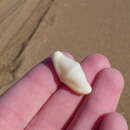fi
nimet breadcrumb-navigoinnissa


The flamingo tongue snail (Cyphoma gibbosum) is a species of small but brightly colored sea snail, a marine gastropod mollusk in the family Ovulidae, the ovulids, cowry allies or false cowries.[2]
A 2017 DNA analysis confirmed that Cyphoma signatum and Cyphoma mcgintyi are genetically homogenous with Cyphoma gibbosum, and that each type are morphological variations of a single species.[3]
Alive, the snail appears bright orange-yellow in color with black markings. However, these colors are not in the shell, but are only due to live mantle tissue which usually covers the shell. The mantle flaps can be retracted, exposing the shell, but this usually happens only when the animal is attacked.
The shells reach on average 25–35 mm (0.98–1.38 in) of length, with a minimum size of 18 mm (0.71 in) and a maximum shell length of 45 mm (1.8 in).[4] The shape is usually elongated and the dorsum shows a thick transversal ridge. The dorsum surface is smooth and shiny and may be white or orange, with no markings at all except a longitudinal white or cream band. The base and the interior of a C. gibbosum shell is white or pinkish, with a wide aperture.
This is the most common of several species in the genus Cyphoma, which lives in the tropical waters of the western Atlantic Ocean from North Carolina to northern coast of Brazil, including off Bermuda, in the Caribbean Sea and the Gulf of Mexico, and off the Lesser Antilles.[5]
The minimum recorded depth is 0.3 m, and the maximum recorded depth is 90 m.[4]

The minimum recorded depth is at the surface, and the maximum recorded depth is 29 m.[4]
The flamingo tongue snail feeds by browsing on the living tissues of the soft corals on which it lives. Common prey include Briareum spp., Gorgonia spp., Plexaura spp., and Plexaurella spp. Adult females of C. gibbosum attach eggs to coral which they have recently fed upon. After roughly 10 days, the larvae hatch. They are planktonic and eventually settle onto other gorgonian corals. Juveniles tend to remain on the underside of coral branches, while adults are far more visible and mobile. An adult scrapes the polyps off the coral with its radula, leaving an easily visible feeding scar on the coral. However, the corals can regrow the polyps, so predation by C. gibbosum is generally not lethal.
This species used to be common, but it has become rather uncommon in heavily visited areas because of over-collecting by snorkelers and scuba divers, who make the mistake of thinking that the bright colors are in the shell of the animal.
 Flamingo Tongue Snail with part of its body out of the shell
Flamingo Tongue Snail with part of its body out of the shell The flamingo tongue snail (Cyphoma gibbosum) is a species of small but brightly colored sea snail, a marine gastropod mollusk in the family Ovulidae, the ovulids, cowry allies or false cowries.
Cyphoma gibbosum is een slakkensoort uit de familie van de Ovulidae. De wetenschappelijke naam van de soort werd in 1758 gepubliceerd door Carl Linnaeus.[1] Hij gaf de naam aan een soort die hem uit de literatuur[2] bekend was van Brazilië. Hij komt voor in het hele gebied van de Golf van Mexico en de Caraïbische Zee, en langs de kust van Oost-Florida en Noord-Brazilië.
De schelp van de slak kan tot 45 millimeter lang worden. De slak leeft in water van minimaal 0,3 meter tot maximaal 90 meter diep.
De soort vertoont veel kleurvariatie, en verschillende kleurvormen en -patronen zijn in de loop der tijd als aparte soorten beschreven en benoemd. In 1973 gaf Crawford Neill Cate een beperkt overzicht van de synonymie.[3] Felix Lorenz en Dirk Fehse (2009) plaatsten Cyphoma finkli in de synonymie van Cyphoma signatum, en C. robustior en C. lindae in die van C. mcgintyi.[4] In 2017 publiceerden Bastian Reijnen en Sancia van der Meij de resultaten van genetisch onderzoek waarin Cyphoma signatum en Cyphoma mcgintyi, samen met de door Lorenz & Fehse gesynonymiseerde namen, werden toegevoegd aan de synonymie van deze soort.[5]
Cyphoma gibbosum is een slakkensoort uit de familie van de Ovulidae. De wetenschappelijke naam van de soort werd in 1758 gepubliceerd door Carl Linnaeus. Hij gaf de naam aan een soort die hem uit de literatuur bekend was van Brazilië. Hij komt voor in het hele gebied van de Golf van Mexico en de Caraïbische Zee, en langs de kust van Oost-Florida en Noord-Brazilië.
De schelp van de slak kan tot 45 millimeter lang worden. De slak leeft in water van minimaal 0,3 meter tot maximaal 90 meter diep.
De soort vertoont veel kleurvariatie, en verschillende kleurvormen en -patronen zijn in de loop der tijd als aparte soorten beschreven en benoemd. In 1973 gaf Crawford Neill Cate een beperkt overzicht van de synonymie. Felix Lorenz en Dirk Fehse (2009) plaatsten Cyphoma finkli in de synonymie van Cyphoma signatum, en C. robustior en C. lindae in die van C. mcgintyi. In 2017 publiceerden Bastian Reijnen en Sancia van der Meij de resultaten van genetisch onderzoek waarin Cyphoma signatum en Cyphoma mcgintyi, samen met de door Lorenz & Fehse gesynonymiseerde namen, werden toegevoegd aan de synonymie van deze soort.
Cyphoma signatum Pilsbry & McGinty, 1939
СинонимыЗнаковая цифома[1] (Cyphoma signatum) — вид брюхоногих моллюсков рода Cyphoma, семейства [Ovulidae]].[2]
Вид распространён в Мексиканском заливе, Карибском море, а также у побережья Малых Антильских островов, восточной Флориды и северной Бразилии.
Размер раковины от 24 до 45 мм[3]. Обитают на глубине от 0,3 до 90 м.
Знаковая цифома (Cyphoma signatum) — вид брюхоногих моллюсков рода Cyphoma, семейства [Ovulidae]].
指头海兔螺(学名:Cyphoma gibbosum)是一种海兔螺科的海洋腹足纲軟體動物[1]。
该物种分布在墨西哥湾、加勒比海、小安的列斯群岛、佛罗里达东海岸以及巴西北部。
壳的尺寸为24毫米至45毫米之间。有记载的最大的壳长度为45毫米[2]。基於化感作用,本物種的外套膜展現出多彩的顏色,以致本物種過往曾被錯誤地按其型態或色彩而劃分成多個物種:事實上這些物種間的遺傳物質完全相同[1][3]。
生活在0.3米至90米深的海域。[2]